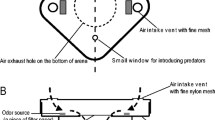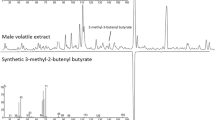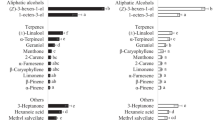Abstract
The behavioral response of the predatory bug Orius laevigatus Fieber to synthetic analogues of secondary plant metabolites was studied. Two compounds most attractive to the bug, methyl salicylate and methyl jasmonate, were identified by olfactometer experiments and pot bioassays. The use of natural volatiles or their analogues as attractants for beneficial insects can significantly improve the efficiency of biological pest control methods.
Similar content being viewed by others
References
Aldrich, J.R., Oliver, J.E., Shifflet, T., et al., “Semiochemical Investigations of the Insidious Flower Bug, Orius insidiosus (Say),” J. Chem. Ecol. 33(8), 1477–1493 (2007).
Arab, A., Trigo, J.R., Lourenção, A.L., et al., “Differential Attractiveness of Potato Tuber Volatiles to Phthorimaea operculella (Gelechiidae) and the Predator Orius insidiosus (Anthocoridae),” J. Chem. Ecol. 33(10), 1845–1855 (2007).
Burov, V.N., Petrova, M.O., Stepanycheva, E.A., “Direct and Indirect Plant Defense Responses in a Tritrophic System,” Vestnik Zashch. Rast., No. 3, 69–70 (2002).
Burov, V.N., Stepanycheva, E.A., Selitskaya, O.G., et al., “Indirect Defense Reaction of Cucumbers Induced by Herbivorous Arthropods,” Entomol. Obozr. 84(4), 721–727 (2005) [Entomol. Rev. 85 (9), 1034–1038 (2005).]
Burov, V.N., Petrova, M.O., Selitskaya, O.G., et al., Induced Plant Resistance to Phytophages (KMK Sci. Press, Moscow, 2012) [in Russian].
Carvalho, L.M., Bueno, V.H.P., and Castane, C., “Olfactory Response towards Its Prey Frankliniella occidentalis of Wild and Laboratory-Reared Orius insidiosus and Orius laevigatus,” J. Appl. Entomol. 135(3), 177–183 (2011).
Chermenskaya, T.D., Burov, V.N., Maniar, S.P., et al., “Behavioral Responses of Western Flower Thrips, Frankliniella occidentalis (Pergande), to Volatiles from Three Aromatic Plants,” Insect Sci. Appl. 21(1), 67–72 (2001).
Dissevelt, M., Altena, K., and Ravensberg, W.J., “Comparison of Different Orius species for Control of Frankliniella occidentalis in Glasshouse Crops in the Netherlands,” Med. Fac. Landbouw. Rijksuniv. Gent 60(30), 839–846 (1995).
Dobrokhotov, S.A. and Saprykin, A.A., “The Role of Entomophages in Pepper and Eggplant Protection from Thrips in Greenhouses,” in Phytosanitary Improvement of Ecosystems: Proc. of II All-Russian Congr. of Plant Protection, St. Petersburg, December 5–10, 2005. Vol. 2 (St. Petersburg, 2005), pp. 40–42.
Hardie, J., Isaacs, R., Pickett, J.A., et al., “Methyl Salicylate and (-)-(1R,5S)-Myrtenal are Plant-Derived Repellents for Black Bean Aphid, Aphis fabae (Homoptera: Aphidae),” J. Chem. Ecol. 20(11), 2847–2855 (1994).
Izhevskii, S.S., “Attraction of Entomophages to Agrocenoses,” Zashch. Karantin Rast., No. 6, 37–38 (1999).
James, D.G., “Further Field Evaluation of Synthetic Herbivore-Induced Plant Volatiles as Attractants for Beneficial Insects,” J. Chem. Ecol. 31(3), 481–495 (2005).
James, D.G. and Price, T.S., “Field-Testing of Methyl Salicylate for Recruitment and Retention of Beneficial Insects in Grapes and Hops,” J. Chem. Ecol. 30(8), 1613–1628 (2004).
Katerinopoulos, H., Pagona, G., Afratis, A., et al., “Composition and Insect Attracting Activity of the Essential Oil of Rosmarinus officinalis,” J. Chem. Ecol. 31(1), 111–122 (2005).
Koschier, E.H., de Kogel, W.J., and Visser, J.H., “Assessing the Attractiveness of Volatile Plant Compounds to Western Flower Thrips Frankliniella occidentalis,” J. Chem. Ecol. 26(12), 2643–2655 (2000).
Koschier, E.H., Hoffmann, D., and Riefler, J., “Influence of Salicylaldehyde and Methyl Salicylate on Post-Landing Behavior of Frankliniella occidentalis Pergande,” J. Appl. Entomol. 131(5), 362–367 (2007).
Krasavina, L.P., Trapeznikova, O.V., and Orlova, G.S., “Rearing of Orius laevigatus and Its Use against Thrips,” Zashch. Karantin Rast., No. 2, 47–48 (2013).
Lee, J.C., “Effect of Methyl Salicylate-Based Lures on Beneficial and Pest Arthropods in Strawberry,” Environ. Entomol. 39(2), 653–660 (2010).
Mallinger, R.E., Hogg, D.B., and Gratton, C., “Methyl Salicylate Attracts Natural Enemies and Reduces Populations of Soybean Aphids (Hemiptera: Aphididae) in Soybean Agroecosystems,” J. Econ. Entomol. 104(1), 115–124 (2011).
Michelakis, S.E. and Amri, A., “Integrated Control of Frankliniella occidentalis in Grete-Greece,” Bull. IOBS/WPRS 20(4), 9–176 (1997).
Mochizuki, M. and Yano, E., “Olfactory Response of the Anthocorid Predatory Bug Orius sauteri to Thrips-Infested Eggplants,” Entomol. Exp. Appl. 123(1), 57–62 (2007).
Murai, T., Imai, T., and Maekawa, M., “Methyl Anthranilate as an Attractant for Two Thrips Species and the Thrips Parasitoid Ceranisus menes,” J. Chem. Ecol. 26(11), 2557–2565 (2000).
Omer, A.D., Thaler, J.S., Granett, J., and Karban, R., “Jasmonic Acid Induces Resistance in Grapevines to a Root and Leaf Feeder,” J. Econ. Entomol. 93, 840–845 (2000).
Omer, A.D., Granett, J., Karban, R., and Villa, E.M., “Chemically-Induced Resistance against Multiple Pests in Cotton,” Int. J. Pest Manag. 47(1), 49–54 (2001).
Pascual-Villalobos, M.J. and Robledo, A., “Screening for Anti-Insect Activity in Mediterranean Plants,” Ind. Crop. Prod. 8(3), 183–194 (1998).
Sanchez, J.A., Garcia, F., Lacasa, A., et al., “Response of the Anthocorids Orius laevigatus and Orius albidipennis and the Phytoseiid Amblyseius cucumeris for Control of Frankliniella occidentalis in Commercial Crops of Sweet Peppers in Plastics Houses in Murcia (Spain),” Bull. IOBS/WPRS 20(4), 177–185 (1997).
Saprykin, A.A. and Pazyuk, I.M., “Biological Control of Thrips: Rearing and Use of the Predatory Orius Bugs,” Gavrish, No. 3, 26–29 (2003).
Schaller, M. and Nentwig, W., “Olfactory Orientation of the Seven-Spot Ladybird Beetle, Coccinella septempunctata (Coleoptera: Coccinellidae): Attraction of Adults to Plants and Conspecific Females,” Eur. J. Entomol. 97(2), 155–159 (2000).
Selitskaya, O.G., Shamshev, I.V., Shchenikova, A.V., and Burov, V.N., “Response of Western Flower Thrips Females to Anisaldehyde: Behavior Analysis and Field Experiments,” in Bioactive Substances in Plant Protection: Proc. Symp. (St. Petersburg, 1999), pp. 42–44.
Teulon, D.A.J., Penman, D.R., and Ramakers, P.M.J., “Volatile Chemicals for Thrips (Thysanoptera: Thripidae) Host-Finding and Applications for Thrips Pest Management,” J. Econ. Entomol. 86(5), 1405–1415 (1993).
Teulon, D.A.J., Hollister, B., Butler, R.C., and Cameron, E.A., “Color and Odor Responses of Flying Western Flower Thrips: Wind Tunnel and Greenhouse Experiments,” Entomol. Exp. Appl. 93(1), 9–19 (1999).
Van de Veire, M. and Tirry, L., “Integrated Pest Management in Glasshouse Sweet Peppers in Belgium in 1998,” Parasitica 54(2–3), 89–94 (1999).
Van Laerhoven, S., Gillespie, D.R., and McGregor, R.R., “Leaf Damage and Prey Type Determine Search Effort in Orius triticolor,” Entomol. Exp. Appl. 97(2), 167–174 (2000).
Vuorinen, T., Nerg, A.-M., Ibrahim, M.A., et al., “Emission of Plutella xylostella-Induced Compounds from Cabbages Grown at Elevated CO2 and Orientation Behavior of the Natural Enemies,” Plant Physiol. 135(4), 1984–1992 (2004).
Yu, H., Zhang, Y., Wu, K., et al., “Field-Testing of Synthetic Herbivore-Induced Plant Volatiles as Attractants for Beneficial Insects,” Environ. Entomol. 37(6), 1410–1415 (2008).
Woods, J.L., James, D.G., Lee, J.C., Gent, D.H., “Evaluation of Airborne Methyl Salicylate for Improved Conservation Biological Control of Two-Spotted Spider Mite and Hop Aphid in Oregon Hop Yards,” Exp. Appl. Acarol. 55(4), 401–416 (2011).
Zhu, J. and Park, K.C., “Methyl salicylate, a Soybean Aphid Induced Plant Volatile Attractive to the Predator Coccinella septempunctata,” J. Chem. Ecol. 31(8), 1733–1746 (2005).
Author information
Authors and Affiliations
Corresponding author
Additional information
Original Russian Text © E.A. Stepanycheva, M.O. Petrova, T.D. Chermenskaya, I.V. Shamshev, I.M. Pazyuk, 2014, published in Entomologicheskoe Obozrenie, 2014, Vol. 93, No. 3, pp. 510–517.
Rights and permissions
About this article
Cite this article
Stepanycheva, E.A., Petrova, M.O., Chermenskaya, T.D. et al. The behavioral response of the predatory bug Orius laevigatus Fieber (Heteroptera, Anthocoridae) to synthetic volatiles. Entmol. Rev. 94, 1053–1058 (2014). https://doi.org/10.1134/S0013873814080016
Received:
Published:
Issue Date:
DOI: https://doi.org/10.1134/S0013873814080016




